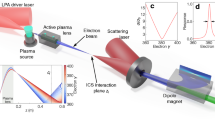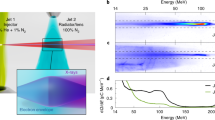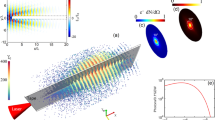Abstract
One of the major goals of research for laser-plasma accelerators1 is the realization of compact sources of femtosecond X-rays2,3,4. In particular, using the modest electron energies obtained with existing laser systems, Compton scattering a photon beam off a relativistic electron bunch has been proposed as a source of high-energy and high-brightness photons. However, laser-plasma based approaches to Compton scattering have not, to date, produced X-rays above 1 keV. Here, we present a simple and compact scheme for a Compton source based on the combination of a laser-plasma accelerator and a plasma mirror. This approach is used to produce a broadband spectrum of X-rays extending up to hundreds of keV and with a 10,000-fold increase in brightness over Compton X-ray sources based on conventional accelerators5,6. We anticipate that this technique will lead to compact, high-repetition-rate sources of ultrafast (femtosecond), tunable (X- through gamma-ray) and low-divergence (∼1°) photons from source sizes on the order of a micrometre.
This is a preview of subscription content, access via your institution
Access options
Subscribe to this journal
Receive 12 print issues and online access
$209.00 per year
only $17.42 per issue
Buy this article
- Purchase on Springer Link
- Instant access to full article PDF
Prices may be subject to local taxes which are calculated during checkout




Similar content being viewed by others
References
Esarey, E., Schroeder, C. B. & Leemans, W. P. Physics of laser-driven plasma-based accelerators. Rev. Mod. Phys. 81, 1229–1285 (2009).
Rousse, A. et al. Production of a keV X-ray beam from synchrotron radiation in relativistic laser-plasma interaction. Phys. Rev. Lett. 93, 135005 (2004).
Kneip, S. et al. Bright spatially coherent synchrotron X-rays from a table-top source. Nature Phys. 6, 980–983 (2010).
Cipiccia, S. et al. Gamma-rays from harmonically resonant betatron oscillations in a plasma wake. Nature Phys. 7, 867–871 (2011).
Schoenlein, R. W. et al. Femtosecond X-ray pulses at 0.4 Å generated by 90 Thomson scattering: a tool for probing the structural dynamics of materials. Science 274, 236–238 (1996).
Albert, F. et al. Characterization and applications of a tunable, laser-based, MeV-class Compton-scattering gamma-ray source. Phys. Rev. ST Accel. Beams 13, 070704 (2010).
Hartemann, F. V. High Field Electrodynamics (CRC Press, 2001).
Catravas, P., Esarey, E. & Leemans, W. P. Femtosecond X-rays from Thomson scattering using laser wakefield accelerators. Meas. Sci. Technol. 12, 1828–1834 (2001).
Hartemann, F. V. et al. Compton scattering X-ray sources driven by laser wakefield acceleration. Phys. Rev. ST Accel. Beams 10, 011301 (2007).
Schwoerer, H., Liesfeld, B., Schlenvoigt, H-P., Amthor, K-U. & Sauerbrey, R. Thomson-backscattered X-rays from laser-accelerated electrons. Phys. Rev. Lett. 96, 014802 (2006).
Kapteyn, H. C., Murnane, M. M., Szoke, A. & Falcone, R. W. Prepulse energy suppression for high-energy ultrashort pulses using self-induced plasma shuttering. Opt. Lett. 16, 490–492 (1991).
Doumy G. et al. Complete characterization of a plasma mirror for the production of high-contrast ultraintense laser pulses. Phys. Rev. E 69, 026402 (2004).
Malka, V. et al. Electron acceleration by a wake field forced by an intense ultrashort laser pulse. Science 298, 1596–1600 (2002).
Jackson, J. D. Classical Electrodynamics (Wiley, 1975).
Wilkins, S. W., Gureyev, T. E., Gao, D., Pogany, A. & Stevenson, A. Nature 384, 335–338 (1996).
Shah, R. C. et al. Coherence-based transverse measurement of synchrotron X-ray radiation from relativistic laser–plasma interaction and laser-accelerated electrons. Phys. Rev. E 74, 045401 (2006).
Born, M. & Wolf, E. Principles of Optics 6th edn (Pergamon Press, 1980).
Ta Phuoc, K. et al. Imaging electron trajectories in a laser-wakefield cavity using betatron X-ray radiation. Phys. Rev. Lett. 97, 225002 (2006).
Faure, J. et al. Controlled injection and acceleration of electrons in plasma wakefields by colliding laser pulses. Nature 444, 737–739 (2006).
Rechatin, C. et al. Controlling the phase-space volume of injected electrons in a laser-plasma accelerator. Phys. Rev. Lett. 102, 164801 (2009).
Lundh, O. et al. Few femtosecond, few kiloampere electron bunch produced by a laser plasma accelerator. Nature Phys. 7, 219–222 (2011).
Faure, J. et al. Injection and acceleration of quasimonoenergetic relativistic electron beams using density gradients at the edges of a plasma channel. Phys. Plasmas 17, 083107 (2010).
Acknowledgements
The authors acknowledge the European Research Council for support through the PARIS ERC project (contract no. 226424). The authors acknowledge LOA technical staff for experimental assistance.
Author information
Authors and Affiliations
Contributions
K.T.P., S.C. and C.T. conceived and realized the experiment, and contributed equally to this work. K.T.P., S.C., C.T. and V.M. analysed the data. K.T.P., S.C., C.T., V.M., R.C. and A.R. wrote the paper. J.P.G. and A.T. operated the laser system. R.S. proposed the experiment. V.M., A.R. and S.S. supported the project.
Corresponding authors
Ethics declarations
Competing interests
The authors declare no competing financial interests.
Supplementary information
Supplementary information
Supplementary information (PDF 482 kb)
Rights and permissions
About this article
Cite this article
Ta Phuoc, K., Corde, S., Thaury, C. et al. All-optical Compton gamma-ray source. Nature Photon 6, 308–311 (2012). https://doi.org/10.1038/nphoton.2012.82
Received:
Accepted:
Published:
Issue Date:
DOI: https://doi.org/10.1038/nphoton.2012.82
This article is cited by
-
On the synergic approach toward the experimental realization of interesting fundamental science within the framework of relativistic flying mirror concept
Reviews of Modern Plasma Physics (2024)
-
Brilliant femtosecond-laser-driven hard X-ray flashes from carbon nanotube plasma
Nature Photonics (2023)
-
Influence of beam waist radius and initial phase on spectrum and spatial spectrum
Indian Journal of Physics (2023)
-
Transverse X-ray radiation from petawatt-laser-driven electron acceleration in a gas cell
Journal of the Korean Physical Society (2023)
-
Enhancing light yield of Tb3+-doped fluoride nanoscintillator with restricted positive hysteresis for low-dose high-resolution X-ray imaging
Nano Research (2023)



